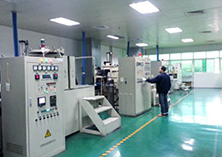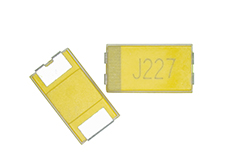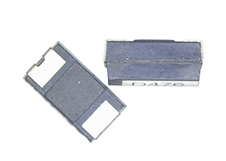Application of thin film technology in electronic components
introduction
Thin film is a special material form, because its size in the specific direction of thickness is very small, it is only a micro measurable quantity, and in the thickness direction, due to the existence of the surface and interface, the continuity of the material is interrupted, which makes the thin film materials have unique properties different from the bulk materials. Now thin film technology is used in electronic components, integrated optics and electronic technology Infrared technology, laser technology, aerospace technology and optical instruments have been widely used. They not only become an independent application technology, but also become an important means of material surface modification and improving some process level
text
The applications of thin films in the following electronic components, film resistors, thin film capacitors and thin film surface acoustic wave devices are introduced.
Thin film resistor
The application of thin films in passive devices begins with resistors. Thin film resistors are made by evaporating certain resistivity materials on the surface of insulating materials. Generally speaking, when the metal is made into thin films, the intrinsic resistivity will increase and the temperature coefficient of resistance will decrease.
Ni Cr Thin film resistor. It is the first metal film resistor to be studied deeply. It has the characteristics of low temperature coefficient, low noise and long life. The commonly used NiCr film resistors are cylindrical and square plate.
The manufacturing process is as follows: firstly, Ni Cr composite films are deposited on the insulating substrate by evaporation and sputtering. Then, the resistance value is adjusted by modifying technology, and the resistance value is corrected by cutting helix with mechanical method. The resistance of parallel plate can be adjusted by mechanical or laser method. Finally, solder the lead wire and package it.
Tantalum film resistor
Tantalum is a high melting point metal, but the temperature coefficient and stability of tantalum are not very good. Therefore, the tantalum nitride (tan) film was prepared by sputtering in high-purity nitrogen, and its resistance was similar to that of Ni Cr Thin film resistance film is similar, its stability is good, but tantalum is a rare metal, so the cost will be higher, which is unfavorable to mass production. Therefore, the promotion of discrete components is not much, but it can obtain very superior properties in Huihe circuit, so it is preferred.
Technical ceramic film resistor
Although the characteristics of NiCr and tantalum film resistors are very high, there is an obvious disadvantage that the resistance value is not easy to be high. In order to make up for this, we can use technology and inorganic materials, namely cermet,
According to the percentage of each phase, cermets can be divided into two types: ceramic matrix and metal matrix. Ceramic based cermets mainly include: ① oxide based cermets. It is composed of alumina, zirconia, magnesium oxide, beryllium oxide and tungsten, chromium or cobalt. It has the characteristics of high temperature resistance, chemical corrosion resistance, good thermal conductivity and high mechanical strength. It can be used as missile nozzle liner, crucible and metal cutting tool for melting metal. ② Carbide based cermets. It is made of titanium carbide, silicon carbide, tungsten carbide and other metals with cobalt, nickel, chromium, tungsten, molybdenum and other metals. It has the characteristics of high hardness, high wear resistance and high temperature resistance. It is used to manufacture cutting tools, high temperature bearings, sealing rings, thread picking die sets and turbine blades. ③ Nitride based cermet. With titanium nitride, boron nitride, silicon nitride and tantalum nitride as the matrix, it has super hardness, thermal vibration resistance and good high temperature creep, so it is seldom used. However, from the point of repeatability and stability, the practical application is limited to CR SiO. The square resistance of Cr SiO cermets with the ratio of Cr to SiO varies greatly. Generally speaking, the higher the Cr content, the smaller the TCR. The square resistance increases with the increase of Si. But in the actual ratio of 1:1, the square resistance is about 1K ohm / □, so the resistance value made by the same figure is about five times of Cr SiO. But the life is not very ideal, so this kind of material is only used in M ohm resistance.
Film capacitance
There are many kinds of capacitors, such as electrolyte capacitors, paper capacitors, film capacitors, ceramic capacitors, mica capacitors, air capacitors, etc. However, the most frequently used audio equipment are electrolytic capacitors and film capacitors. Electrolytic capacitors are mostly used in places where a large amount of capacitance is needed. For example, the filter capacitor of the main power supply is used for storing electric energy besides filtering. Thin film capacitors are widely used in analog signal cross connect, power noise bypass (anti cross connect) and so on. Thin film capacitor is a kind of capacitor with metal foil as electrode, which is overlapped with plastic film such as polyethylene, polypropylene, polybenzene or polycarbonate from both ends and wound into a cylindrical structure. According to the type of plastic film, they are called poly (ethyl ester) (Mylar), polypropylene (PP), polystyrene (PS) and polycarbonate.
Thin film capacitor is a kind of excellent capacitor because of its many excellent characteristics. Its main properties are as follows: non polarity, high insulation impedance, excellent frequency characteristics (wide frequency response), and small dielectric loss. Based on the above advantages, thin film capacitors are widely used in analog circuits. Especially in the part of signal cross connection, capacitors with good frequency characteristics and very low dielectric loss must be used to ensure that the signal will not be greatly distorted during transmission. Among all the plastic film capacitors, polypropylene (PP) capacitor and polystyrene (PS) capacitor have the most remarkable characteristics. Of course, the prices of these two kinds of capacitors are also relatively high. However, in recent years, in order to improve the sound quality of audio equipment, the parts materials used have become more and more advanced, and the price is not the most important factor to be considered. Therefore, in recent years, the frequency and quantity of PP and PS capacitors used in audio equipment are increasing. Readers can often see the brand of equipment, claimed to use a brand of PP capacitor or PS quality capacitor, as an endorsement of sound quality, the reason is here.
The common method of making thin film capacitor is to take aluminum and other metal foil as electrode and then roll it together with plastic film. But in addition, there is another way to make thin film capacitors, called metallized film. The method is to vacuum evaporate a thin layer of metal on a plastic film to act as an electrode. In this way, the thickness of the electrode foil can be omitted, and the volume per unit capacity of the capacitor can be reduced. Therefore, the thin film capacitor can be easily made into a small and large capacity capacitor. For example, the common MKP capacitor is the synonym of metallized polypropylene film capacitor, and MKT is the synonym of metallized polyethylene film capacitor.
The films used in metallized film capacitors include polyethylene, polypropylene, polycarbonate, etc. in addition to the winding type, there are also laminated types. The metallized film capacitor has a so-called self healing action, that is, if a small part of the electrode is short circuited due to the weak electrical interface, the electrode metal around the short-circuit part will cause a larger area of dissolution due to the electrostatic energy or short-circuit current carried by the capacitor at that time Melting and evaporation to restore insulation, so that the capacitor again restore the role of the capacitor.
In general applications, the polyester film shows good characteristics, such as high dielectric constant (which makes it obtain the highest unit volume electric capacity in metallized film capacitor), high insulation strength, self recovery characteristics and good temperature stability. Among all kinds of film capacitors, polyester capacitors achieve the best volumetric efficiency at moderate cost and are the most popular choice for DC applications such as decoupling, blocking, bypass and noise suppression.
The capacitor made of metallized polypropylene film has the characteristics of low dielectric loss, high insulation impedance, low dielectric absorption and high insulation strength. It is a durable and space saving solution, and its long-term stability is also very good. These characteristics make metallized polypropylene film capacitors an important choice for applications such as AC input filters, electronic ballasts and snubber circuits. Polypropylene film capacitors can provide 400VAC or higher rated voltage to meet the requirements of industrial three-phase applications and professional equipment. They can also be used in switching power supply, frequency discrimination and filter circuits, as well as energy storage and sampling and holding applications.
Thin film capacitor is an important component in the electronic industry. Although the corresponding production and structure technology is constantly developing to provide greater capacitance and better electrical performance, these devices are rarely related to the new characteristics of new products. In this case, because people often need to quickly complete the design and component selection, when there is a special demand, the capacitor manufacturer provides one-to-one service, which can help solve the design problems and ensure the smooth completion of the basic function modules such as interference filter, basic signal regulation circuit and electronic ballast.
Thin film SAW devices
In the surface acoustic dialing device, the energy of surface acoustic wave is concentrated in the surface layer of piezoelectric substrate. The thickness of the surface layer is the wavelength of one surface wave. Therefore, the SAW devices can be fabricated without piezoelectric single crystal or piezoelectric ceramic substrate and covered with piezoelectric thin film of about one wavelength
In thin film SAW devices, multilayer structure is formed by piezoelectric film and non piezoelectric substrate, and the propagation characteristics of saw are determined by the characteristics of piezoelectric film and substrate. That is to say, when the thickness of the film and the substrate material are changed, the sound velocity, center frequency, delay time and temperature characteristics of saw will also change. In addition, the effective electromechanical coupling coefficient of saw varies with the electrode structure of transducer and the thickness of piezoelectric film.
summary
Thin film technology has been widely used in electronic components, and its excellent characteristics are irreplaceable.




















